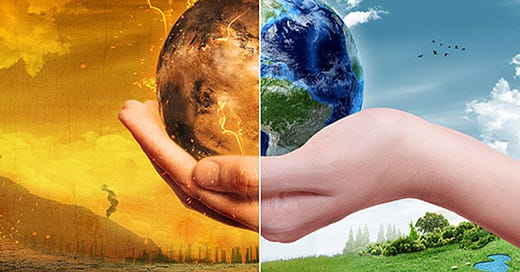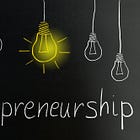Superabundance: How Freedom and Innovation drive Prosperity
And how is this intrinsically related to Entrepreneurship and Population Growth.
Welcome Austrian reader!
In today’s post we’ll be introducing Superabundance.
A concept following this Newsletter’s mental model of freedom & prosperity.
Hope you enjoy it!
"The first thing to be remembered is that economics deals with scarcity. As long as there is an unlimited abundance of something, there is no economic problem."
― Ludwig Von Mises
Introduction
The Primitive Fear: Scarcity and Population Growth
For centuries, humanity has grappled with the fear that our growing numbers would lead to the exhaustion of the Earth’s resources. This anxiety, rooted in observations from the animal kingdom, is understandable.
Normally, a sudden increase in resources, such as a surplus of grass after a rainy season, often leads to a rapid rise in animal populations.
However, this population boom is usually followed by a decrease of resources and, subsequently, a dramatic population collapse. This cycle of boom and bust seems inevitable in the natural world, and for much of human history, people appeared similarly bound to these cycles of fortune.
The fear of resource scarcity reached new heights during the 20th century, when many believed that humanity was on a collision course with disaster. The population was growing rapidly, and it seemed logical to assume that this would lead to the depletion of vital resources, sparking widespread famine, poverty, and conflict. But, this terrible outlook failed to account for one critical factor: human action.
The Human Action
Cooperation, Trade, and Innovation
Unlike other species, humans have developed sophisticated ways to overcome the challenges posed by our environment. Our ability to cooperate, trade, and innovate has allowed us to break free from the natural cycles of scarcity that trap other species. The Scottish economist Adam Smith, in his 1776 classic The Wealth of Nations, identified trade as a key differentiator between humans and other animals. While animals might share resources within families or engage in simple exchanges, they do not trade in the complex, deliberate way that humans do.
Trade has been particularly vital during times of scarcity. For instance:
“When a region is struck by drought, its people can trade with others to obtain the food and resources they need to survive.”
This ability to engage in exchange, rather than relying solely on what is locally available, has been a cornerstone of human survival and prosperity.
However, trade is just one aspect of what sets humans apart. Our superior intelligence and capacity for innovation have played an even more crucial role in transforming potential scarcity into abundance. Over thousands of years, humanity has accumulated a vast store of knowledge, allowing us to develop technologies that have fundamentally altered our relationship with the natural world.
From Scarcity to Abundance: The Power of Innovation
The transition from scarcity to abundance began in earnest toward the end of the 18th century. This period marked the dawn of the Industrial Revolution, a time when technological advancements started to break the old constraints that had limited human productivity. As new inventions and processes emerged, they dramatically increased the efficiency of production, allowing us to produce more with less.
Today, the world is incomparably richer and more productive than it was just two centuries ago. The Four Horsemen of the Apocalypse—wars, hunger, pandemics, and death—though not entirely vanquished, have been significantly diminished in their impact on human life. This progress is evident in the vast array of goods and services available to us, from the hundreds of types of breakfast cereals on supermarket shelves to the widespread availability of life-saving medications.
A key concept that helps us understand this transformation is "superabundance." Superabundance refers to the idea that resource abundance has not only kept pace with population growth but has actually outstripped it. This is contrary to the Malthusian fear that more people would inevitably lead to less for everyone. In reality:
“The more people we have, the more ideas are generated, and the more resources are ultimately created.”
This concept has to be with previous posts such as Entrepreneurship, or even the impediment of the impediment of such a free human action through a political posture like Socialism.
Measuring Progress: The Concept of Time Prices
To fully appreciate the extent of our progress, it's essential to look beyond traditional measures like money prices and instead focus on "time prices."
A “time price” measures the amount of time a person must work to afford something, offering a more accurate reflection of prosperity. Unlike money prices, which can be distorted by inflation and other economic factors, time prices account for both rising incomes and the decreasing costs of goods and services due to innovation. For example:
“If a barrel of oil costs $75 and you earn $15 an hour, the time price is five hours. If the price of oil increases to $80 but your income rises to $20 an hour, the time price actually decreases to four hours.”
This method of measurement shows how innovation not only reduces costs but also increases earnings, allowing people to afford more with less effort over time.
The concept of time prices was central to the famous wager between economist Julian Simon and biologist Paul Ehrlich in the 1980s.
Ehrlich, fearing that population growth would lead to resource depletion, predicted that the prices of five key metals would rise over the decade.
Simon, on the other hand, believed that human innovation would drive prices down, even as populations grew.
Simon’s victory was a testament to the power of human creativity and the dynamic relationship between scarcity and innovation.
Superabundance: The Triumph of Human Creativity
The success of Simon’s bet reflects a broader truth: in free and open markets (The essence of Austrian Economics), scarcity stimulates innovation, leading to greater abundance. This dynamic relationship between population growth, resource availability, and innovation is at the heart of the concept of superabundance.
When we applied the time price framework to a wide range of goods and services spanning two centuries, the results were astonishing. Resources have become more abundant, often at a rate that outpaces population growth. This trend is driven by human creativity and our relentless pursuit of new solutions to old problems.
Contrary to the dire predictions of resource depletion, the data suggests that as populations grow, so too does our capacity to innovate, resulting in more resources for everyone. This phenomenon highlights the importance of freedom in fostering innovation and ensuring continued progress.
The Role of Freedom and Population Growth
While the evidence for superabundance is compelling, the future of this progress is not guaranteed. The very factors that have driven our success—freedom and a growing population—are under threat from ideologies that are anti-natalist, anti-growth, and anti-progress. To ensure that humanity continues on its path of abundance, we must avoid three critical mistakes.
First, we must resist the spread of anti-humanist ideas that discourage population growth. A shrinking population means fewer minds to generate the ideas that drive innovation and prosperity.
Second, we must protect the freedom of expression. Innovation thrives in an environment where people are free to think, speak, and share ideas without fear of censorship or retaliation.
Lastly, we must defend the freedom of markets. Overregulation and undue restrictions can stifle the very mechanisms that have allowed us to turn scarcity into abundance.
Conclusion
A Future of Hope and Abundance
The journey from scarcity to abundance is one of humanity's greatest achievements. By leveraging our unique abilities to trade, innovate, and cooperate, we have transformed the challenges of population growth into opportunities for greater prosperity.
The concept of superabundance shows that with the right conditions—freedom (of speech and market) and a growing population—our capacity for innovation knows no boundaries.
As we look to the future, it is essential that we continue to foster these conditions, ensuring that the progress we've made is not only sustained but accelerated. The more people we have, and the greater their freedom is to create and trade, the greater the possibilities that we will continue to thrive in a world of abundance rather than scarcity.
In the end, human creativity is our greatest resource, and as long as we nurture it, there is every reason to be optimistic about the future.
Are you a new Austrian reader? Do not hesitate to follow me.
And do not forget to check-out the About you page as well.
May also interest you:
Disclosure: Not Investment Advice
The content provided in "Austrian Goggles" is for informational purposes only and should not be considered as financial, legal, or investment advice. The opinions expressed are those of the author and are based on research and analysis of current market conditions. While we strive to ensure the accuracy of the information presented, there is no guarantee of its completeness or reliability. Any investment decisions you make are your responsibility, and you should consult with a qualified financial advisor before making any investment decisions. The author and contributors to this newsletter are not liable for any losses or damages arising from your use of the information provided.






